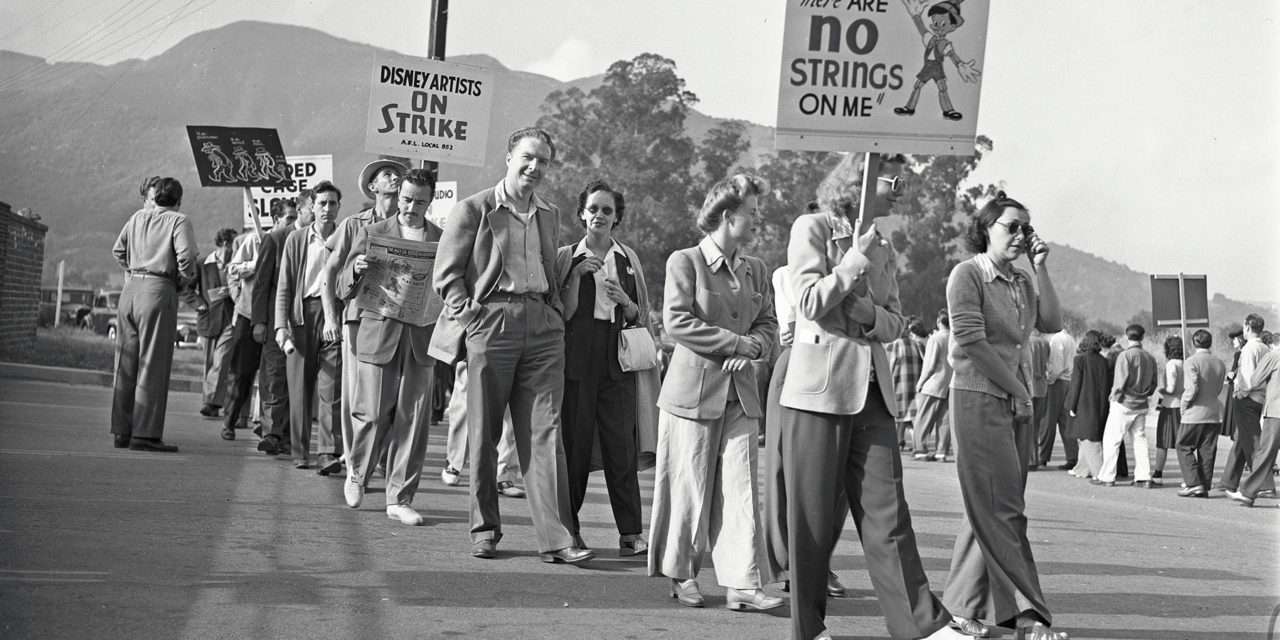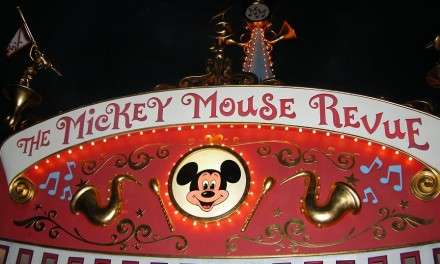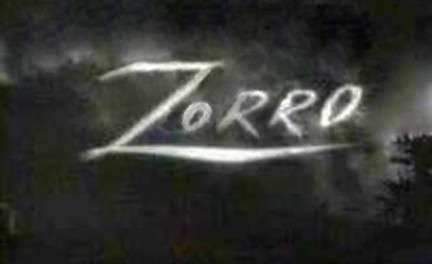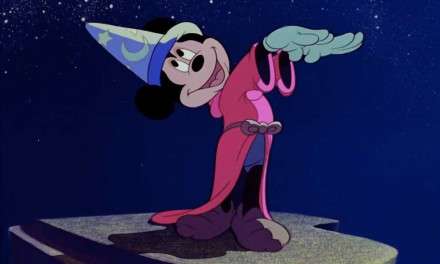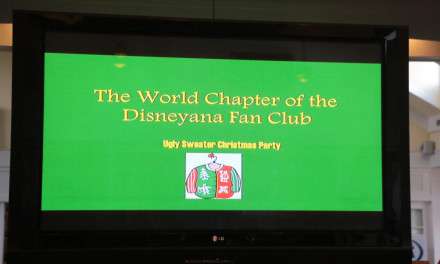One of Walt Disney’s most salient quotes of the many he articulated over the years was…” All the adversity I’ve had in my life, all my troubles and obstacles, have strengthened me… You may not realize it when it happens, but a kick in the teeth may be the best thing in the world for you” This imposing quote is relevant to everyone in the world, for no one can go through life without its pitfalls. Most people think that Walt became famous with the creation of Mickey Mouse and Disneyland and all was right with his world. But this is far from the reality, and Diane Disney Miller, Walt’s daughter always lamented on the flood of mediocre and poorly written biographies and false rumors written about her father. One of her biggest criticisms was how many treated her famous dad as a god, putting him on a pedestal so to speak, and ignoring the fact he was a man like anyone else, with faults and subject of many controversies. She preferred him to be remembered as a father and husband, with all the imperfections and missteps of any other man.
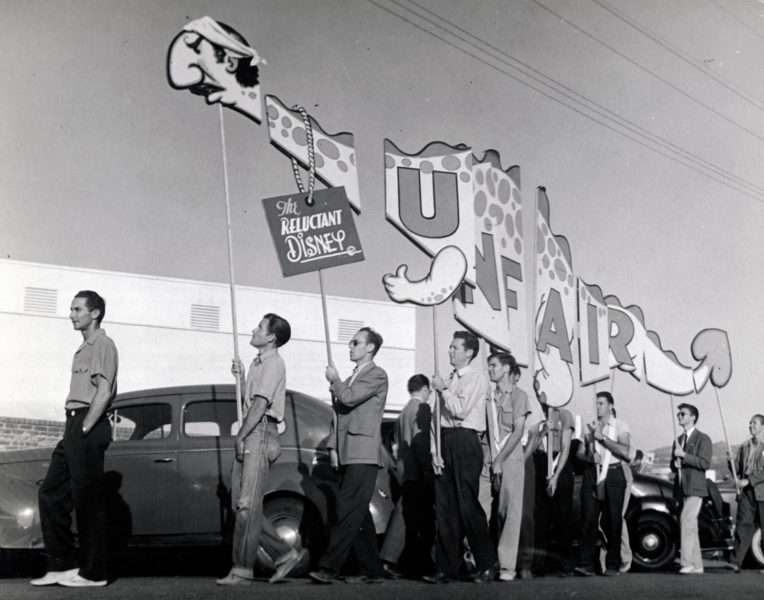
Because some of these “faults”, one of the greatest and perhaps most life-changing events occurred in Walt’s career, and it came to be known as the “Disney Animator’s strike of 1941” But to say the strike was primarily because of Walt is not true in any sense, every strike has a multiplicity of factors and events and to understand how this came about, we have to understand the climate of the era and World conditions. There were many factors and controversies in the Disney studio that were also major contributors.
The Disney studio perceived labor problems that were unlike labor struggles of the past decade. Most people of the time assumed that working at Disney was in a happy-go-lucky atmosphere and they envisioned Walt that of an inventive genius. Most industrial unions were comprised of semi-skilled and unskilled workers, and unions focused on wage scales and safety. The animation industry tackled with workplace atmosphere, recognition, and intellectual differences.
It was during the early ‘30’s that the burgeoning entertainment industry began to join into unions. Many actors, editors, writers, and directors had slowly formed organizations around this mammoth drive for union identification. In 1933, the “Screen Actors Guild” a union was created for the motion picture industry. In 1932 a union was created for the unrepresented animation workers in Hollywood and New York, however, it was referred to as a “club” so not to tip off employers. These “clubs” held member meetings in secret for several years to avoid being fired if their employers found out. Yet in 1937, after a successful strike by animation workers of Fleischer Studios in New York forced their employers to recognize the union, the Screen Cartoonists Guild in 1938. The animators in Hollywood announced they would establish a branch of the Screen Cartoonists Guild the following year.
The union leader was a tough Hollywood union organizer and leader, Herbert Sorrell. After the strike with Fleischer he secured contracts with Walter Lantz Productions, Terrytoons, Screen Gems, Metro-Goldwyn-Mayer and George Pal. Although producer Leon Schlesinger, who gave us the popular Looney Tunes and Merrie Melodies cartoons for Warner Brothers, strove for a lockout, after employees went on strike, he relented and signed with the union. After signing, Schlesinger asked…” What about Disney?”
At the time, Disney’s artists and animators were the highest paid (For some) and worked amid the best conditions in the industry, the newly constructed Burbank studio in California. One must remember that Walt and his studio had grown from a few artists and friends in a storefront to this massive studio where 1293 employees toiled six days a week. However, many were discontented. Walt once gave 20 percent of profits from the cartoon shorts to employees as bonuses. In 1936, the practice stopped. After the success of Snow White and the completion of the Burbank studio, a rigid hierarchy system came to be. Many departments were in segregated buildings, and worker benefits, like access to the steam room, gymnasium, restaurant and even the sumptuous and spacious offices were privy only to the top writers and animators. In addition, Walt reinvested profits back into the studio. No screen credits were allowed other than Walt’s. In addition, raises and bonuses were sporadically given at management’s whim. Other factors included the less successful films, Pinocchio and Fantasia, the gathering storm clouds of World War II, which shrunk the overseas movie market. The once folksy cartoonist of yore, Uncle Walt was now known as Mr. Disney, who was now a capitalist with many worries. Walt always thought himself just “one of the guys”, but most saw him as the boss. He grew more and more isolated from his artists and animators.
 In 1940, because of the failures of Pinocchio and Fantasia, Disney had to make layoffs. The pay structure at the studio was completely disorganized, the higher-ranking animators pulling in as much as $200 to $300 a week, and many lower-ranking workers as little as $12 a week. One of Disney’s highest paid animators, Art Babbitt, who was the creator of Goofy and credited with many other milestones in the company, was supportive to the lower paid employees, and he with many other employees joined the Screen Cartoonists Guild. Sadly, Walt was unconscious of the complaints, still believing it was the “good old days” and viewed them as a family, thinking they should be grateful to him for providing the new studio space and a job. Workers discontent continued to grow. Differences included professional disparities over standards of excellence, property rights, screen credits and long hours in a sometimes hostile and tense environment. As the business burgeoned beyond that small storefront studio, Walt also felt pressured. Walt was aware of his lack of personal control over studio endeavors, he became increasingly more dictatorial to prove he was in charge. Very fearful of this labor agitation and growing union shops, he created a company union, known as the Disney Federation of Screen Cartoonists, which was no more than a puppet union to keep those who complained at bay.
In 1940, because of the failures of Pinocchio and Fantasia, Disney had to make layoffs. The pay structure at the studio was completely disorganized, the higher-ranking animators pulling in as much as $200 to $300 a week, and many lower-ranking workers as little as $12 a week. One of Disney’s highest paid animators, Art Babbitt, who was the creator of Goofy and credited with many other milestones in the company, was supportive to the lower paid employees, and he with many other employees joined the Screen Cartoonists Guild. Sadly, Walt was unconscious of the complaints, still believing it was the “good old days” and viewed them as a family, thinking they should be grateful to him for providing the new studio space and a job. Workers discontent continued to grow. Differences included professional disparities over standards of excellence, property rights, screen credits and long hours in a sometimes hostile and tense environment. As the business burgeoned beyond that small storefront studio, Walt also felt pressured. Walt was aware of his lack of personal control over studio endeavors, he became increasingly more dictatorial to prove he was in charge. Very fearful of this labor agitation and growing union shops, he created a company union, known as the Disney Federation of Screen Cartoonists, which was no more than a puppet union to keep those who complained at bay.
Walt decided to speak to his employees in masse to contain the situation. In February 1941, with all of 1200 workers in the auditorium, Walt gave the following spiel… “In the 20 years I’ve spent in this business I’ve weathered many storms. It’s been far from easy sailing. It required a great deal of work, struggle, determination, competence, faith, and above all unselfishness. Some people think we have class distinction in the place. They wonder why some people get better seats in the theatre than others. They wonder why some men get spaces in the parking lot and others don’t. I have always felt, and always will feel that the men that contribute most to the organization should, out of respect alone, enjoy some privileges. My first recommendation to the lot of you is this; put your own house in order, you can’t accomplish a damn thing by sitting around and waiting to be told everything. If you’re not progressing as you should, instead of grumbling and growling, do something about it”.
Instead of galvanizing his employees, most left the auditorium infuriated and recruited even more employees to join the Screen Cartoonist’s Guild. Meanwhile, tensions between Disney and Art Babbitt were reaching a peak when Babbitt became one of the union leaders which Walt saw as a personal betrayal. On advice of Leonard Genofski, lawyer of the Disney Federation of Screen Cartoonists, Babbitt called a meeting with Walt, Roy and company lawyer Gunther Lessing and asked for a $2 and hour raise for the inkers. Roy was outraged and told Babbitt… “You keep your nose out of our business or we’ll cut it off!” It was now clear to Babbitt that the union only served to keep workers from forming a union shop. Herb Sorrell contacted Babbitt and the two attempted to organize the Disney workers to join the Screen Cartoonists Guild. They gathered four-hundred union cards out of a staff of five hundred and sixty eligible workers and approached management.
After Walt’s speech, on May 26th, 1941 the workers voted to strike. Disney’s own backers urged him to negotiate, but he refused. A final negotiation meeting was held on May 28th, Walt was not willing to give up anything. Sorrell attempted to play tough guy and intimidated Walt… “I can make a dustbowl of your studio!” It was then that Babbitt was fired along with 16 other cartoonists belonging to the SCG. This firing was the bitter end. Two days later, a mass meeting was held by the Disney employees where the motion to strike was put forward by an assistant to Babbitt and the strike was called by Sorrell to start the next day, May 29, 1941. Incidentally, Babbitt who had a strong union ethos, was instrumental in keeping the strike going over the coming weeks.
When Walt came to the studio, he found the entrance ringed with a gang of 300 picketers and reporters. These were his own cartoonists. Many stood on soapboxes, making speeches, hand painted signs proclaimed… DISNEY UNFAIR! ONE GENIUS vs. 600 GUINEA PIGS, WE HAD NO SCABS AT SCHLESINGERS, LEONARDO, MICHELANGELO and TITIAN WERE UNION MEN, and a picture of Pluto with the title, ID RATHER BE A DOG THAN A SCAB! Driving through the mob, Walt, on one occasion leaped out of his car to attack Art Babbitt, only to be stopped by several protesters. The strike lasted five weeks. Near the end, Walt consented to a suggestion by Nelson Rockefeller, head of the Latin American Affairs office, that he make a tour of Latin America as a goodwill ambassador. In addition to Walt removed from the strike, enabling tempers to cool off, the tour resulted in the package films Saludos Amigos and the Three Caballeros. With the help of Roy and a federal mediator, the strike was settled, and the Guild won favor on every issue. The studio signed a contract and has been a union shop since.
The strike made the greatest impact upon the history of Hollywood animation than anything before it. The Disney Strike generated new studios, new creative styles, new characters and changed animation forever. To the people who witnessed it, was a defining moment in their lives and careers. New friendships were forged and old ones broken. Many carried their anger for the rest of their lives. The damage to the psychology and mood of the studio was done. Before the strike, there was approximately 1,200 employees, in the aftermath, only 694 remained. Slowly, the pro-union artists were made to feel unwanted and wafted away from the studio. If there was a staff cutback, the union supporters were always the first to go, and, when the Federally mandated 90-day arbitration period ended, Walt fired even more. Those who tried to stay got the silent treatment. In this close working space where tempers and tensions exist, it was difficult to concentrate, and the stress levels were intolerable. Art director Noble stated…” No one wanted to speak to me, even in the men’s room”. So they slowly left… Bill Tytla, Jules Engel, Frank Tashlin, Ade Woolery, Margaret Selby, Chris Ishi, John Hubley, Harry Reeves, Zack Schwartz, Bill Scott, Bill Hurtz, Phil Klein, Dave Hilberman, Steve Bosustow, Aurelius Battaglia, Hicks Lokey and Ed Forcher. Some went into the service, others to Screen Gems. Some formed the new company United Productions of America, called UPA. Art Babbitt, now hated by Walt, brought an unfair labor practices suit against Walt and he was forced to rehire him after the war. Walt blamed Babbitt for initiating the strike, never forgave him. Babbitt did leave Disney on his own free will in 1947. And no incident in his career had a greater impact on Walt Disney himself. The family atmosphere and comradery of former times was gone forever. Walt felt betrayed and was never sure if he could trust anyone again, even his most loyal animators and writers, and never quite forgave the people who had been part of the strike. The strike was a defining moment in the history of the Disney studios.
In 1956, Walt Disney, when asked about those times, said… “In the end, the strike was a good thing because it cleaned house over there better than I could have ever done”. Ward Kimball, one of the Nine Old Men, said… “I was quite liberal, yet I didn’t go out on strike. But I knew something had to be done. And I agree to this day that it was a good thing that it happened”
Walt had many bumps on his road to overseeing the greatest storytelling and family entertainment business ever known, but the biggest bump was without question, the 1941 Animators Strike.

